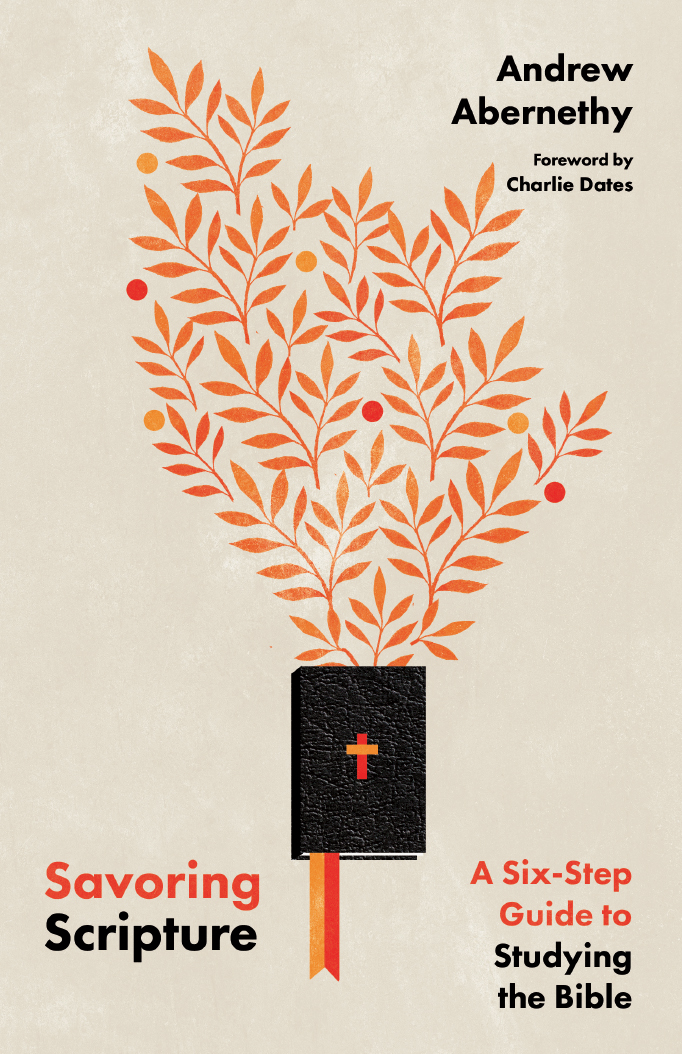A Conversation on Savoring Scripture with Andrew Abernethy
Drawing from his experience training students to study the Bible, Andrew Abernethy provides a holistic six-step method for Bible study in his book Savoring Scripture. In this interview, he shares how Christians can rediscover the joy in reading Scripture in a way that combines textual analysis and the transformation work of the Holy Spirit.
What are some factors that cause people to lose their enjoyment in reading Scripture?
Andrew Abernethy: Helping readers kindle joy in reading the Bible depends entirely on why we read the Bible. Often, we settle for making Bible study an end in itself. We master factoids. We check “read the Bible” off the to-do list of our guilty evangelical consciences. We draw on academic training to discern what a passage might have meant originally. Over time, our enjoyment diminishes. What we lose sight of is that the Bible is a means but not the end. The aim of reading the Bible is to savor and respond to the living God who makes himself known and speaks through Scripture today.
What sorts of people do you think will appreciate Savoring Scripture?
Abernethy: My sense is that lots of professors see a gap between academic biblical studies and spiritual formation. In most books on how to read the Bible, the focus is on figuring out what a passage meant historically. As a result, students end up feeling like they are on a remote island, disconnected from God and what God might have to say to us today. Professors will be glad to have a resource to assign to students that will help their faith soar rather than sour as they also develop foundational academic skills in Bible reading.
Alongside its use in classrooms, I hope churches will value Savoring Scripture too. Many in the church feel lost when reading the Bible. They have been told, “read your Bible,” yet they receive no guidance on how to do so profitably.
You present six steps for reading the Bible. How did you choose and develop these steps?
Abernethy: The six steps (posture, flow, context, whole Bible, savor God, respond faithfully) stem from my years of teaching biblical interpretation and my own personal journey. Early in my teaching career, I followed the standard academic path of helping students develop skills in reading a passage according to its flow of thought and genre (step 2) and in factoring in historical and book contexts (step 3). Given my interests in biblical theology, I next began including more guidance on how to read a passage in light of the entire Bible, centered on Jesus (step 4). Eventually, steps 1, 5, and 6 fell into place for me after a season of spiritual renewal through Bible reading while on a sabbatical. If I wanted to teach students to read the Bible according to its own nature as God’s Word, then I needed to include our dependence on God to make himself known (step 1). I sought to offer clarity on the aim of communion with God through Scripture (step 5). I then moved away from the idea of application, which seems so impersonal and human centered, to speak of responding faithfully to what God is saying through his Word today (Step 6). Pretty soon after these steps fell into place I sensed God calling me to write this book.
Have you found that any of the steps particularly resonate with students? Are any particularly challenging?
Abernethy: By far, the steps my students love the most are 1, 5, and 6. They realize these are a bit outside of the academic box, and they love being able to integrate academic study with engagement with God in real life.
The most difficult step tends to be reading a passage for its flow of thought (step 2). Students are so used to picking bits and pieces from a passage that they find it challenging to follow its flow and see what the passage is driving it. This might be the most time-intensive step, yet students regularly speak of it as the most important.
Your process begins with our posture in reading Scripture, which should include teachability and childlikeness. Why are these important?
Abernethy: Think of it this way. The Pharisees and scribes of Jesus’s day knew the contents of the Bible more than any of us today. Yet, they were completely off the mark because they assumed they had Scripture figured out. Jesus counters this assumption. He praises God for making himself known to “children” rather than to the “wise and learned.” If we start the process of reading Scripture from a posture of teachability and childlikeness, this will position all of us—whether veteran or newbie Bible readers—to hear from God throughout the rest of the steps.
This interview originally appeared in the IVP Academic catalog. Sign up to receive the catalog to be the first to discover new academic books and author interviews.





